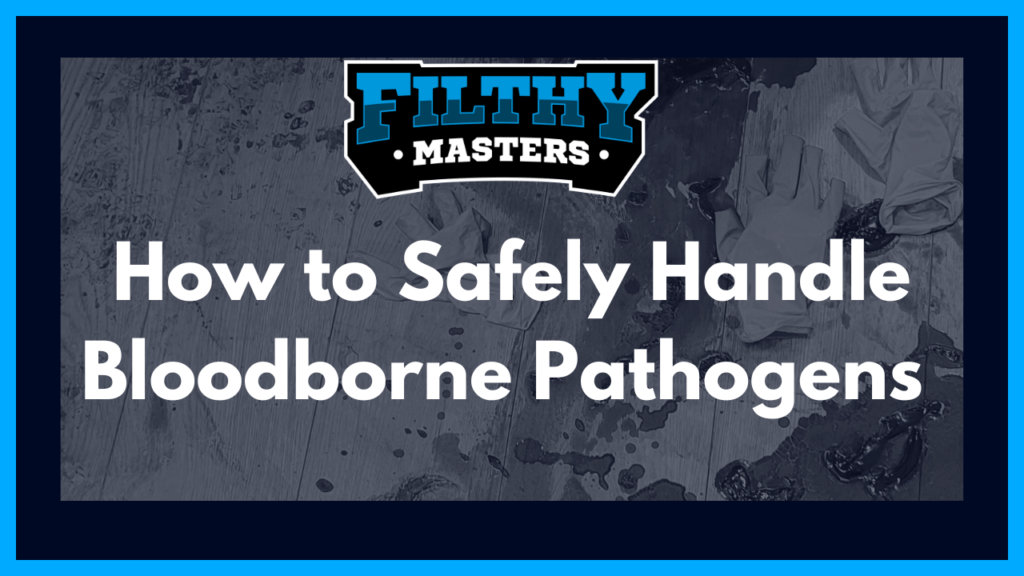Call Today - 24/7 Emergency Services
Table of Contents
How to Safely Handle Bloodborne Pathogens in a Home or Business – A Guide to Proper Containment, PPE, and Legal Considerations
- February 26, 2025
Handling bloodborne pathogens safely is critical in both home and business environments. Whether you’re a cleaning professional, healthcare worker, or simply someone dealing with an unexpected biohazard situation, knowing how to protect yourself and others from potential exposure is essential. This guide provides a detailed approach to containment, personal protective equipment (PPE), and legal considerations to ensure safe handling.

What Are Bloodborne Pathogens?
Bloodborne pathogens are microorganisms, such as viruses or bacteria, that are carried in human blood and can cause disease in individuals. These pathogens are primarily transmitted through direct contact with infected blood, but they can also be found in other bodily fluids. They present a significant health risk in environments where there is potential for exposure to blood, such as healthcare settings, emergency services, or cleaning operations.
Common Diseases Transmitted Through Blood
Several serious diseases are transmitted through exposure to bloodborne pathogens, including:
HIV (Human Immunodeficiency Virus) – A virus that weakens the immune system, making the body more vulnerable to infections and diseases. If left untreated, it can lead to AIDS.
Hepatitis B – A viral infection that attacks the liver, potentially leading to long-term liver damage, cirrhosis, and liver cancer.
Hepatitis C – A viral infection similar to Hepatitis B, affecting the liver, and can lead to chronic liver disease if not properly managed.
Malaria – A parasitic infection transmitted through blood, usually by the bite of an infected mosquito, but can also be spread via blood transfusion or needle-sharing.
Syphilis – A sexually transmitted infection (STI) that can also be spread through blood contact.
How Bloodborne Pathogens Spread
Bloodborne pathogens spread in various ways, primarily through exposure to infected blood or other bodily fluids. The main routes of transmission include:
Direct Blood-to-Blood Contact – When an individual comes into contact with infected blood through open wounds, cuts, or mucous membranes (such as in the eyes, nose, or mouth).
Needle Stick Injuries – Healthcare workers or others handling needles, syringes, or sharp objects may accidentally get pricked by contaminated needles or sharp instruments.
Blood Transfusions or Organ Transplants – If the blood or organ has not been properly screened for pathogens, there’s a risk of transmitting infections.
Sharing Needles or Other Drug Paraphernalia – People who share needles or drug paraphernalia are at a high risk of contracting bloodborne diseases, especially HIV and Hepatitis B or C.
Mother-to-Child Transmission – Some bloodborne pathogens, such as HIV and Hepatitis B, can be passed from an infected mother to her child during childbirth or breastfeeding.
Preventing the spread of bloodborne pathogens involves proper hygiene, the use of protective equipment (like gloves), safe disposal of needles and sharps, and following strict protocols in medical, cleaning, and emergency situations.
Safety Measures for Handling Bloodborne Pathogens
To prevent exposure to bloodborne pathogens, it’s essential to follow strict safety protocols. This includes using personal protective equipment (PPE), following containment and cleanup procedures, and maintaining proper hand hygiene. Adhering to these measures helps reduce the risk of infection in environments where bloodborne pathogens may be present.
Personal Protective Equipment (PPE)
Personal protective equipment (PPE) serves as a critical barrier between workers and potentially infectious materials. PPE is necessary when handling blood or blood-contaminated items to protect skin, mucous membranes, and clothing.
Types of PPE Required
Gloves – Essential for protecting hands from direct contact with blood or other bodily fluids. Disposable gloves made of nitrile or latex are commonly used.
Gowns/Aprons – Protective clothing that covers the body and prevents contamination from blood splashes or spills.
Masks and Face Shields – Used to protect the face and eyes from bloodborne pathogens, especially when there’s a risk of splashing or spraying blood.
Eye Protection – Goggles or face shields that protect the eyes from blood splashes or droplets.
Boots or Shoe Covers – To prevent contamination of shoes and feet when working in areas with visible blood spills.
Proper Use and Disposal of PPE
- Use: PPE should be worn before coming into contact with blood or potentially infectious materials. Ensure that gloves are intact, masks fit properly, and goggles or face shields are securely positioned to cover vulnerable areas.
- Disposal: PPE should be discarded immediately after use in designated biohazard disposal containers. Never reuse disposable PPE items, as they can become contaminated. Ensure all items are placed in appropriate waste containers to minimize exposure risks.
Additional Precautions for High-Risk Environments
Bloodborne Pathogen Safety in Healthcare Settings
- Hospitals, clinics, and nursing homes handle bodily fluids regularly, making them high-risk environments for bloodborne pathogen exposure. Healthcare workers must follow strict protocols, including:
- Regular hand hygiene before and after patient contact.
- Proper disposal of contaminated medical supplies.
- Immediate reporting and treatment of needlestick injuries
- Proper Handling of Needles and Sharps
- Always use puncture-resistant sharps containers.
- Never recap used needles.
- Dispose of sharps immediately after use to prevent accidental injuries.
- Safe Handling in Crime Scene Cleanup and Biohazard Remediation
- Professional cleanup crews dealing with crime scenes, suicides, or unattended deaths must:
- Use specialized PPE, such as full-body suits and respirators.
- Follow strict containment and decontamination procedures.
- Properly dispose of biological waste according to federal and provincial regulations.
Advanced Decontamination Methods
Using UV-C Light for Pathogen Elimination
UV-C light technology is becoming a popular method for disinfecting surfaces. It works by destroying the DNA of harmful pathogens, effectively neutralizing them. This method is especially useful in:
Healthcare facilities
Laboratories
High-traffic commercial spaces
Chemical Disinfection vs. Steam Cleaning
Chemical Disinfection: CEPA-approved disinfectants can kill bloodborne pathogens, but they must be applied correctly and allowed to sit for the recommended dwell time.
Steam Cleaning: High-temperature steam can penetrate porous surfaces and kill bacteria and viruses, making it a useful option for carpets and upholstery.
Best Practices for Deep Cleaning After an Incident
Seal off the contaminated area until properly cleaned.
Use disposable cleaning materials whenever possible.
Conduct post-cleaning air quality tests if necessary.
Conclusion
Bloodborne pathogens pose a serious risk, but with the right knowledge, PPE, and procedures, exposure can be minimized. Whether at home or in a business setting, understanding containment, legal requirements, and emergency responses ensures safety for everyone involved.
FAQs
1. What are the most common bloodborne pathogens?
Hepatitis B, Hepatitis C, and HIV are the most frequently encountered bloodborne pathogens.
2. How long can bloodborne pathogens survive outside the body?
Some, like Hepatitis B, can survive for up to a week on surfaces, while others, like HIV, die quickly once exposed to air.
3. What should I do if I accidentally touch contaminated blood?
Immediately wash the area with soap and water, and seek medical advice if necessary.
4. Are there specific cleaning products needed for bloodborne pathogen cleanup?
Yes, certain approved disinfectants effective against HBV, HCV, and HIV should be used.
5. What legal responsibilities do businesses have regarding bloodborne pathogen safety?
Businesses must comply with Alberta OSH regulations, provide proper training, and ensure safe work environments

When You’re Ready to Hire, Contact Filthy Masters for Professional Restoration Services
When choosing a restoration contractor, prioritize experience, certification, and professionalism. Filthy Masters, founded in 2017, is a leader in residential and commercial restoration services, offering a wide range of expertise from fire and water restoration to mould remediation and biohazard cleanup. Our team is on standby to restore your property efficiently and effectively, no matter the disaster.
Visit our website or call (403) 463-9132 to connect with Filthy Masters today. Don’t let disaster linger—let Filthy Masters Save You from Disaster
Share our Blog about Restoration
Feel free to Share our Filthy Masters War Journal Post using the links below.
#bloodborne pathogens #biohazard cleanup #PPE for bloodborne pathogens #OHS compliance #blood spill cleanup #pathogen decontamination #legal considerations, #sharps disposal

